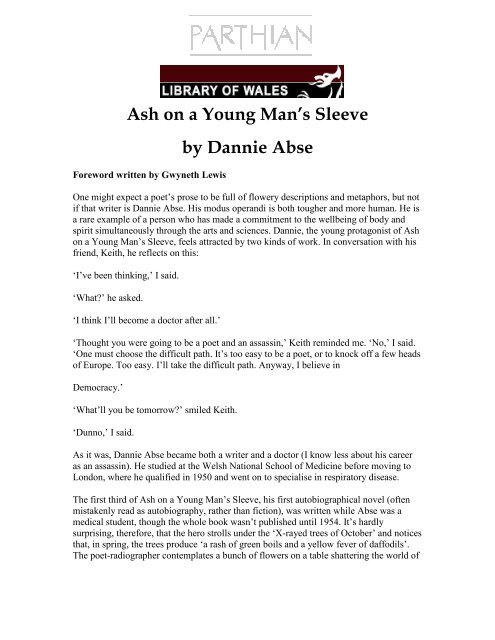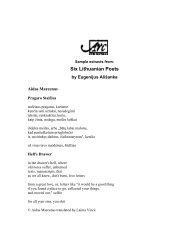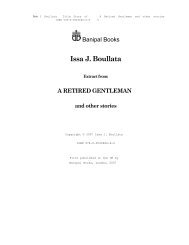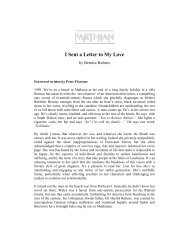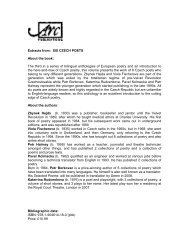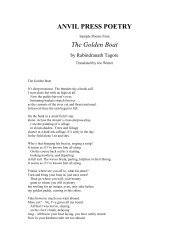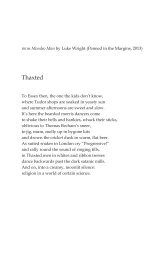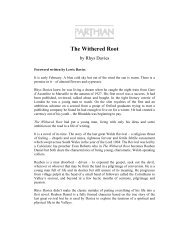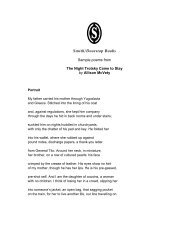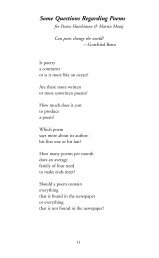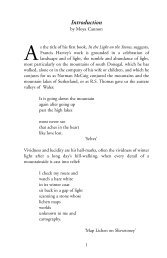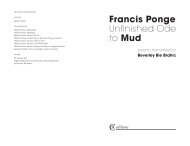Parthian - Foreword written by Gwyneth Lewis.pdf - Inpress Books
Parthian - Foreword written by Gwyneth Lewis.pdf - Inpress Books
Parthian - Foreword written by Gwyneth Lewis.pdf - Inpress Books
Create successful ePaper yourself
Turn your PDF publications into a flip-book with our unique Google optimized e-Paper software.
Ash on a Young Man’s Sleeve<br />
<strong>Foreword</strong> <strong>written</strong> <strong>by</strong> <strong>Gwyneth</strong> <strong>Lewis</strong><br />
<strong>by</strong> Dannie Abse<br />
One might expect a poet’s prose to be full of flowery descriptions and metaphors, but not<br />
if that writer is Dannie Abse. His modus operandi is both tougher and more human. He is<br />
a rare example of a person who has made a commitment to the wellbeing of body and<br />
spirit simultaneously through the arts and sciences. Dannie, the young protagonist of Ash<br />
on a Young Man’s Sleeve, feels attracted <strong>by</strong> two kinds of work. In conversation with his<br />
friend, Keith, he reflects on this:<br />
‘I’ve been thinking,’ I said.<br />
‘What?’ he asked.<br />
‘I think I’ll become a doctor after all.’<br />
‘Thought you were going to be a poet and an assassin,’ Keith reminded me. ‘No,’ I said.<br />
‘One must choose the difficult path. It’s too easy to be a poet, or to knock off a few heads<br />
of Europe. Too easy. I’ll take the difficult path. Anyway, I believe in<br />
Democracy.’<br />
‘What’ll you be tomorrow?’ smiled Keith.<br />
‘Dunno,’ I said.<br />
As it was, Dannie Abse became both a writer and a doctor (I know less about his career<br />
as an assassin). He studied at the Welsh National School of Medicine before moving to<br />
London, where he qualified in 1950 and went on to specialise in respiratory disease.<br />
The first third of Ash on a Young Man’s Sleeve, his first autobiographical novel (often<br />
mistakenly read as autobiography, rather than fiction), was <strong>written</strong> while Abse was a<br />
medical student, though the whole book wasn’t published until 1954. It’s hardly<br />
surprising, therefore, that the hero strolls under the ‘X-rayed trees of October’ and notices<br />
that, in spring, the trees produce ‘a rash of green boils and a yellow fever of daffodils’.<br />
The poet-radiographer contemplates a bunch of flowers on a table shattering the world of
appearances: ‘They were like yellow swans peering down at a surface of shimmering<br />
water. Soon perhaps the tulips would dip their heads through the wooden table…’<br />
Abse’s work possesses a deep wit which doesn’t trivialise its objects, but underlines their<br />
seriousness. Many poets, Abse included, are great joke-tellers. It’s as if jokes are an<br />
important dress rehearsal for poems. Both rely on timing and defying expectations and<br />
their aim is to overturn a clichéd view of the world. The second time I met Abse, at a<br />
festival in Vienna, I spent a lot of time laughing. He told a story about a rich American<br />
whose wife mistook Dylan Thomas for C.S. Forester and congratulated the Swansea poet<br />
on his Hornblower novels. When Thomas pointed out that he hadn’t <strong>written</strong> them, the<br />
American turned to his wife and said, wearily, ‘Wrong again, Emily,’ a phrase which, I<br />
have found, has very wide applications in life.<br />
This combination of humour and deep seriousness permeates Ash on a Young Man’s<br />
Sleeve which is a novel about the simultaneous unfolding of innocence and<br />
horror in wartime Europe. We follow the lives of ten-year-old Dannie and his best friend<br />
Keith as they mature into teenagers in south Wales, facing, for the first time, both love<br />
and grief. The young Dannie takes Lydia Pike, his first girlfriend, up to the open fields in<br />
Cyncoed and has this poignant conversation:<br />
‘I’m going to kiss you,’ I said.<br />
She feebly tried to stop me. After she said: ‘You’re not like other boys. You kiss<br />
differently. You don’t make me feel sick when you kiss me.’ I wondered how<br />
other boys kissed her and which boys.<br />
‘How do you mean?’ I questioned her.<br />
‘You keep your lips closed when you kiss,’ she whispered. What did she mean? Of<br />
course I kept my lips closed. Was there any other way of kissing?<br />
This bitter-sweet process is set in the context of the Spanish Civil War and the Holocaust.<br />
Indeed, the work as a whole shows how world events have a devastating impact on the<br />
seemingly domestic. Born to a Jewish family in Cardiff, Dannie is made politically aware<br />
<strong>by</strong> his brother Leo’s campaigning activities on the Spanish Civil War (Abse’s nonfictional<br />
brother Leo was a solicitor and Labour Member of Parliament) and <strong>by</strong> the<br />
family discussions of what was happening on the Continent. Alongside the very local<br />
concerns of friendships and family, the narrator imagines the<br />
world of continental Europe, 1938, personified in a Polish Jew, Grynszpan, whom his<br />
brother Wilfred describes to him (‘not a person… but a condition of history’, says Leo).<br />
Grynszpan, entering the German Embassy in Parish with the intention of assassinating<br />
the ambassador, notices the carpet, which highlights his powerlessness: ‘the thick, greycoloured<br />
luxurious carpet beneath his feet intimidated him… made him conscious of his
own appearance, his own inadequacy… it was as if he walked on cotton wool. The carpet<br />
was so thick that it disturbed his balance organs: he walked over like a drunkard, but with<br />
no noise.’ This is the textile which he eventually stains with the blood of the German<br />
official whom he shoots. This passage works symbolically as well as realistically, and its<br />
structure is a kind of proto-poem.<br />
As a whole, the novel is a classic account of a friendship between two boys, Dannie and<br />
Keith. The sheer animal existence of young children is beautifully evoked. When Dannie<br />
goes to Keith’s house for tea – ‘There’ll be bananas and cream, so you can leave as soon<br />
as you’ve eaten ’em’ – he’s embarrassed to be caught sniffing the strange smell of other<br />
people’s houses. In the park, Dannie is beaten up <strong>by</strong> an enemy and finds his knees<br />
bleeding ‘for the gravel pathway had curiously risen to meet me’. Abse catches exactly<br />
the rhythmic speech patterns of children:<br />
‘I like Barry best,’ said Keith.<br />
‘I like Ogmore best,’ I said.<br />
‘I like Porthcawl best,’ said Keith.<br />
‘I like Cold Knap best,’ I said.<br />
‘I like Laverknock best,’ said Keith.<br />
‘I like Southerndown best,’ Keith said.<br />
‘I like Barry best,’ I said.<br />
‘I like Barry best,’ Keith said.<br />
‘Fight you for it,’ I said.<br />
Abse writes searingly well about the vulnerability of children to the weaknesses of adults.<br />
When Keith and Dannie visit Barry Island on their own for the first time, they have a<br />
blissful time until, on the return journey, the man sharing their railway carriage has an<br />
epileptic fit in front of them and wets himself. Suddenly the body becomes a frightening<br />
entity, with a will of its own. The day is ruined. In another incident, a man in a lane<br />
touches Keith in too intimate a manner and Dannie jokes that Keith has the Black Curse.<br />
The joke goes tragically wrong when Keith’s mother dies of a stroke and both boys, with<br />
the literal-mindedness of children, believe that the curse has been fulfilled. Keith and his<br />
father’s grief, as observed <strong>by</strong> Dannie, is threaded throughout the novel. Indeed, the title<br />
of the novel is a quotation from T.S. Eliot’s Little Gidding, referring to the dust of a<br />
loved but disappeared life. Later in the book, both boys go camping to Ogmore. Keith<br />
falls in love with Henrietta Gregory, the young wife of a rich man who allows them to<br />
camp in the grounds of his house. She’s recovering from a nervous breakdown and, with<br />
the casual cruelty of an adult, fails to take seriously Keith’s passion for her. The whole
visit is an unforgettable evocation of the sensibilities that are somewhere between those<br />
of children and young men. Dannie, abandoned <strong>by</strong> his friend, feels jealous and lonely but<br />
can’t articulate this directly:<br />
‘Funny thing, Keith, I met a mermaid when I went for a swim this morning.’ ‘How<br />
come?’ he would ask. ‘It was like this – I heard somebody shouting for help and I swam<br />
out miles to sea and there she was, almost drowning.’ My friend would ask, ‘A mermaid<br />
drowning?’ I could see him doubting me. ‘She had cramp,’ I’d explain…<br />
I grew up in the area of Cardiff where Ash on a Young Man’s Sleeve is set. There was a<br />
synagogue at the end of our road and we lived in the middle of Cardiff’s<br />
Jewish community, whose members liked to be within walking distance of their place of<br />
worship. I became engaged in the park where the fictional Dannie plays. The ‘White<br />
Wall’, which surrounds Summers’ funeral parlour is still called that in Cardiff, though it<br />
hasn’t been white for many years. My husband, who was brought up in Cardiff during the<br />
war, like Abse, remembers the way in which the Welsh crowd at a football match would<br />
pass children ‘down over their heads, hand <strong>by</strong> hand, laugh <strong>by</strong> laugh, right to the front’.<br />
No doubt Keith and Dannie were not the only boys to use the roar of the crowd to<br />
camouflage their special rehearsal of swearing.<br />
It’s important for writers to see their own patch depicted in earlier works of the highest<br />
quality: Abse’s Cardiff is a pioneering text in the absorption of Cardiff life into an<br />
imaginative literary tradition, a process that is still continuing. There are plenty of forces<br />
that tell us our lives aren’t important or worthy of literary consideration and Ash on a<br />
Young Man’s Sleeve contradicts them all.<br />
This novel is a huge historical and lyrical achievement. It sketches the landscape that<br />
informs Dannie Abse’s poetry, but its most important contribution is its humorous and<br />
lyrical commitment to the struggles of being human. This is laughter of a high<br />
seriousness, as when the five-year-old Dannie is found with his finger on the nipple of<br />
Clytemnestra’s bust, which stands in his parents’ hall. This is an emblem of Dannie<br />
Abse’s muse as a whole:<br />
I pressed her one stony nipple that peeped over a fold of her stone dress… I posed in that<br />
position for quite a while as Clytemnestra stared down at the floor blankly. The visitors<br />
seemed a trifle embarrassed…. The door banged and mother ushered me into the livingroom<br />
gently, without explanation.<br />
Stony she may have been, but that particular Cardiff Clytemnestra managed to see very<br />
far into wartime Europe and into the souls of boys.<br />
<strong>Gwyneth</strong> <strong>Lewis</strong>


